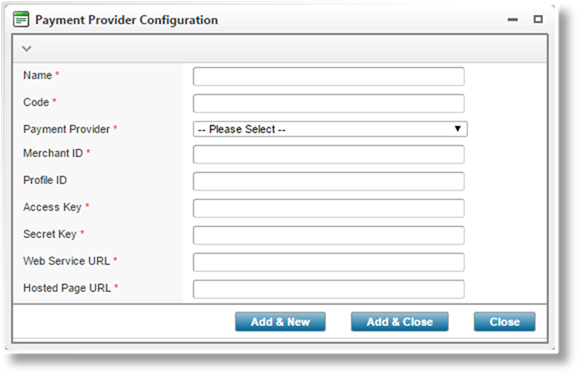
Note: Before configuring the payment provider in the system, an account will need to be created with the chosen provider. They will provide you with the necessary information to complete the configuration.
The online payment feature supports a range of payment providers. The Payment Provider Configuration section is used to define each payment provider with the necessary details for communication with Bridge.
|
|
Note: Before configuring the payment provider in the system, an account will need to be created with the chosen provider. They will provide you with the necessary information to complete the configuration. |
1. In the main menu, select Billing, Configuration, then Payment Provider Configuration. A list of all available configurations is displayed.

|
|
Tip: By default, only Active configurations are displayed. Clear the filter in the Status column to view all configurations. |
2. Click Add. The Payment Provider Configuration window opens.
3. Complete the necessary information. Fields marked with a red asterisk * are required.

|
Name |
Enter the name of the configuration. This name is displayed in the payment provider configuration list and is used to select the payment provider in the system. |
|
Code |
Enter a unique code to identify the payment provider within the system. |
|
Payment Provider |
Select one of the supported payment providers. |
|
Merchant ID |
Enter the ID for the merchant account within the payment provider’s system. This is obtained from the payment provider. |
|
Profile ID |
Enter the ID for the profile within the payment provider’s system. This is obtained from the payment provider. |
|
Access Key |
Enter the access key to provide secure access to the payment provider website. This is obtained from the payment provider. |
|
Secret Key |
Enter the secret key for secure communications between the systems. This is obtained from the payment provider. |
|
Web Service URL |
Enter the URL for payments processed through the web service. This is obtained from the payment provider. |
|
Hosted Page URL |
Enter the URL for payments processed through the hosted page. This is obtained from the payment provider. |
4. Click Add & New to save the configuration and clear the form to enter another payment provider, click Add & Close to save and return to the Payment Provider Configuration List, or click Close to return to the Payment Provider Configuration List without saving the configuration.
5. Once the configuration has been saved, the Status panel is added at the bottom of the window.

|
Active |
Marks the configuration as active and available for use. If unchecked, the configuration is disabled and cannot be used for payments. Any features using this configuration will need to be updated to use an active configuration. |
|
Created By |
Identifies the date and time the configuration was created, and the user who created it. |
|
Last Modified By |
Identifies the last date and time the configuration was changed, and the user who made the changes. |
1. In the main menu, select Billing, Configuration, then Payment Provider Configuration. A list of all available configurations is displayed.

|
|
Tip: By default, only Active configurations are displayed. Clear the filter in the Status column to view all configurations. |
2. Click a link in the Name column to view the configuration details. If there are a large number of available configurations, see the Using Grids section for help on finding the appropriate configuration.
3. See the section on Creating a New Payment Provider Configuration for a detailed description of the fields.
4. Click Save & New to save the configuration and clear the form to enter another payment provider, click Save & Close to save and return to the Payment Provider Configuration List, or click Close to return to the Payment Provider Configuration List without saving the configuration.
Click Deactivate to deactivate the configuration.
Once created, a payment provider configuration cannot be deleted. It can be deactivated so that it cannot be used for payments. Any features using this configuration will need to be updated to use an active configuration.
1. In the main menu, select Billing, Configuration, then Payment Provider Configuration. A list of all available configurations is displayed.

|
|
Tip: By default, only Active configurations are displayed. Clear the filter in the Status column to view all configurations. |
2. Locate the configuration or configurations to be deactivated. If there are a large number of available configurations, see the Using Grids section for help on finding the appropriate configurations.
3. Check the boxes for all configurations to be deactivated.
4. Click Deactivate, then confirm the deactivation when prompted to do so. All selected configurations are deactivated. If the Payment Provider Configuration List is still defaulted to only show active configurations, they disappear from the list.
|
|
Tip: Individual configurations can also be deactivated or reactivated directly through the Payment Provider Configuration window. See the section on Viewing and Modifying a Payment Provider Configuration for details. |